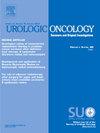Critical care therapy and in-hospital mortality after radical nephroureterectomy for nonmetastatic upper urinary tract carcinoma
IF 2.4
3区 医学
Q3 ONCOLOGY
Urologic Oncology-seminars and Original Investigations
Pub Date : 2025-05-01
DOI:10.1016/j.urolonc.2024.09.035
引用次数: 0
Abstract
Background
Use of critical care therapies (CCT), that include invasive mechanical ventilation (IMV), total parenteral nutrition (TPN) and other modalities are unknown after radical nephroureterectomy (RNU) for upper urinary tract carcinoma (UUTC). Their relationship with in-hospital mortality is also unknown.
Methods
Within the National Inpatient Sample (2008–2019), we identified non-metastatic UUTC patients treated with RNU. Multivariable logistic regression models were used.
Results
Of 8,995 patients, 375 (4.2%) received CCT and 82 (0.9%) experienced in-hospital mortality. Of CCT modalities, 215 (2.4%) received IMV and 139 (1.5%) TPN. Temporal CCT, IMV, and TPN trends very closely followed in-hospital mortality trends. Relative to historical UUTC patients (2008–2013), contemporary (2014–2019) patients exhibited lower CCT (Δ = 2.2%, P value < 0.0001), lower IMV (Δ = 1.4%, P < 0.0001), lower TPN (Δ = 2.2%, P < 0.0001), and lower in-hospital mortality (Δ = 0.4%, P = 0.03) rates. Of in-hospital mortalities, 52 out of 82 received CCT but 30 of 82 did not. Median age (> 72 years; odds ratio [OR] 1.4; P = 0.002) and Charlson comorbidity index ≥ 3 (OR 4.1; P < 0.001) and ≥ 1-2 (OR 1.7; P = 0.001) independently predicted overall higher CCT, IMV, TPN, and in-hospital mortality.
Conclusion
After RNU, CCT rates parallels in-hospital mortality rates. CCT represents a 5 to 6-fold multiple of in-hospital mortality rate. In RNU patients, CCT rates are higher in older and sicker individuals. Lower CCT rates that are paralleled by lower in-hospital mortality may be interpreted as an indicator of improved quality of care. Ideally all in-hospital mortalities should be predated by CCT exposure.
非转移性上尿路癌根治性肾切除术后的重症监护治疗和院内死亡率。
背景:上尿路癌根治性肾切除术(RNU)后,包括侵入性机械通气(IMV)、全肠外营养(TPN)和其他方式在内的重症监护疗法(CCT)的使用情况尚不清楚。它们与院内死亡率的关系也不得而知:在全国住院患者样本(2008-2019 年)中,我们确定了接受 RNU 治疗的非转移性 UUTC 患者。采用多变量逻辑回归模型:在8995名患者中,375人(4.2%)接受了CCT治疗,82人(0.9%)出现院内死亡。在 CCT 方式中,215 人(2.4%)接受了 IMV,139 人(1.5%)接受了 TPN。CCT、IMV和TPN的时间趋势与院内死亡率趋势非常接近。与历史上的 UUTC 患者(2008-2013 年)相比,当代(2014-2019 年)患者的 CCT 率较低(Δ = 2.2%,P 值 < 0.0001),IMV 率较低(Δ = 1.4%,P < 0.0001),TPN 率较低(Δ = 2.2%,P < 0.0001),院内死亡率较低(Δ = 0.4%,P = 0.03)。在院内死亡病例中,82 例中有 52 例接受了 CCT 治疗,但有 30 例未接受 CCT 治疗。中位年龄(> 72 岁;比值比 [OR] 1.4;P = 0.002)和 Charlson 合并症指数≥ 3(OR 4.1;P < 0.001)和≥ 1-2 (OR 1.7;P = 0.001)可独立预测较高的 CCT、IMV、TPN 和院内死亡率:结论:RNU术后,CCT率与院内死亡率相当。CCT是院内死亡率的5至6倍。在 RNU 患者中,年龄越大、病情越重的人 CCT 率越高。与较低的院内死亡率同时出现的较低 CCT 率可被解释为护理质量提高的指标。理想情况下,所有院内死亡病例都应在接触 CCT 之前死亡。
本文章由计算机程序翻译,如有差异,请以英文原文为准。
求助全文
约1分钟内获得全文
求助全文
来源期刊
CiteScore
4.80
自引率
3.70%
发文量
297
审稿时长
7.6 weeks
期刊介绍:
Urologic Oncology: Seminars and Original Investigations is the official journal of the Society of Urologic Oncology. The journal publishes practical, timely, and relevant clinical and basic science research articles which address any aspect of urologic oncology. Each issue comprises original research, news and topics, survey articles providing short commentaries on other important articles in the urologic oncology literature, and reviews including an in-depth Seminar examining a specific clinical dilemma. The journal periodically publishes supplement issues devoted to areas of current interest to the urologic oncology community. Articles published are of interest to researchers and the clinicians involved in the practice of urologic oncology including urologists, oncologists, and radiologists.

 求助内容:
求助内容: 应助结果提醒方式:
应助结果提醒方式:


